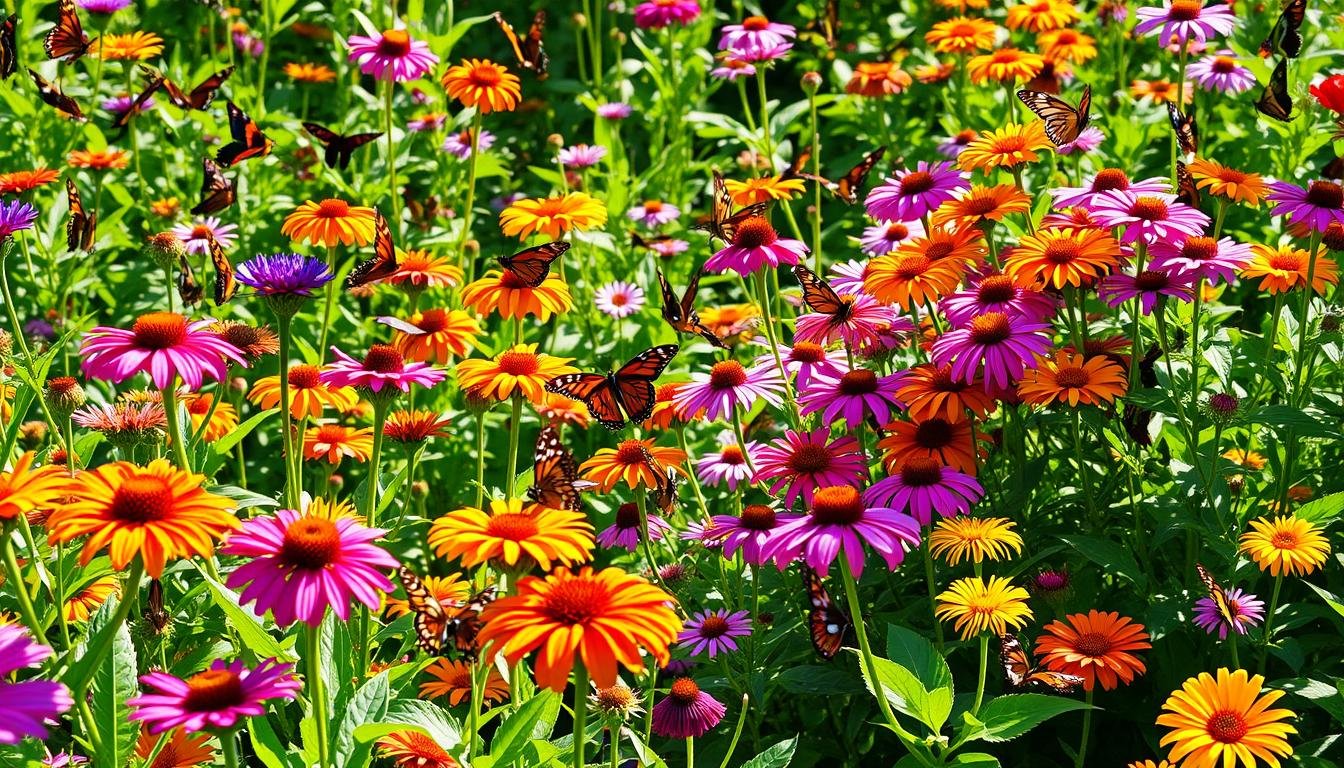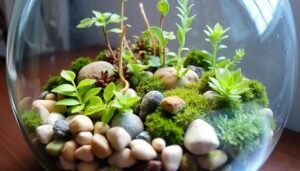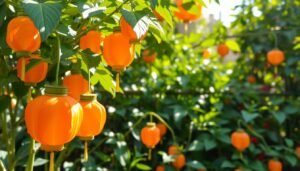If you want to make your garden better and help the environment, think about adding butterfly plants. These colorful flowers are key for drawing in butterflies and other important pollinators like bees and hummingbirds. By choosing plants that attract butterflies, you make your garden look great and help keep nature balanced.
Did you know that pollinators are behind one of every three bites of food we eat? This shows how important it is to have pollinator gardens in our backyards. With plants like milkweed for monarchs and the sweet-smelling butterfly bush, there are many options for these amazing creatures. Learning how to attract butterflies is the first step to a thriving garden ecosystem.
Table of Contents
The Importance of Butterfly Plants in Your Garden
Adding butterfly plants to your garden makes it more beautiful and healthy. Pollinators are key to food production and keeping the environment balanced. You might ask, why are pollinators important in your garden?
Butterflies are vital pollinators that help plants reproduce. They ensure your kitchen garden grows well, giving you plenty of fruits and veggies.
Why Pollinators Matter
Pollinators like butterflies are essential for a diverse ecosystem. They feed other wildlife, helping keep biodiversity strong. Butterfly numbers show how healthy your garden is.
These pollinators also help control pests by eating harmful insects. This means you can use fewer chemicals in your garden. Creating a space for butterflies is good for your garden and the environment.
The Benefits of a Diverse Ecosystem
A diverse ecosystem is full of life, thanks to butterflies. Your garden will attract more plants and animals, including native bees and birds. Butterflies make your garden look beautiful and bring joy.
Watching butterflies can make you feel happier and more connected to nature. For those who garden sustainably, knowing how to help butterflies can improve your garden. Learn more about gardening techniques to help these pollinators thrive.
| Benefit | Description |
|---|---|
| Pollination | Butterflies assist in the reproduction of many plants through cross-pollination. |
| Pest Control | They consume pests like aphids, contributing to natural pest management. |
| Biodiversity | Butterflies support a diverse ecosystem that benefits all garden inhabitants. |
| Mental Well-Being | Observing butterflies can improve mental health by connecting people to nature. |
Characteristics of Ideal Butterfly Plants
When picking plants for your garden, look for those that make lots of nectar and pollen. These foods are key for butterflies to thrive. Knowing when these plants bloom helps ensure butterflies have food all season.
Nectar and Pollen Production
Choose plants that are rich in nectar and pollen. Nectar draws adult butterflies, while pollen is a vital food source. Black-eyed Susan and coneflower are great picks, feeding many butterfly types. Adding annuals like alyssum and zinnia also boosts your garden’s beauty.
Bloom Times to Support Pollinators
Plan your planting schedule with bloom times in mind. Butterflies need food all season, from spring to autumn. By picking plants that bloom at different times, your garden will always be a haven for them.
Native vs. Non-Native Species
Using native plants in your garden is a smart move. They fit well with local weather and soil, making them strong. Plus, some butterflies, like monarchs, need native plants for their caterpillars. While non-native plants have benefits too, native plants usually attract more butterflies.
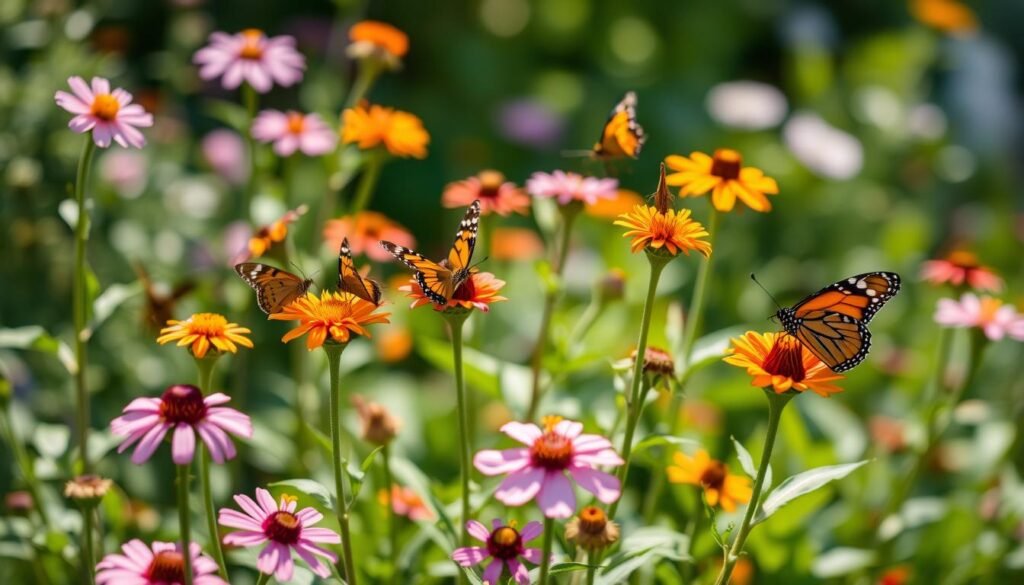
| Type of Plant | Nectar Production | Pollen Production | Best Bloom Times |
|---|---|---|---|
| Black-eyed Susan | High | Moderate | Summer to Fall |
| Butterfly Bush | Moderate | Low | Summer to Fall |
| Coneflower | High | High | Summer |
| Alyssum | Moderate | Low | Spring to Summer |
Best Butterfly Plants for Attracting Pollinators
To make your garden lively, pick plants that look good and help pollinators. Some flowers are key in drawing butterflies and other helpful insects. Here, you’ll find top picks to make your garden more beautiful and eco-friendly.
Popular Butterfly Bushes
Butterfly bushes, like Buddleia, are loved by gardeners for their lots of nectar. They grow 4 to 12 feet tall, making a great spot for butterflies. Their flowers come in many colors, drawing pollinators all summer.
Butterfly Weed: A Must-Have
Butterfly weed, or Asclepias tuberosa, is a must for butterfly gardens. It gives butterflies the nectar they need and helps their young grow. Its bright orange flowers are a highlight in the garden, blooming all summer.
Milkweed for Monarchs
Milkweed is key for monarch butterflies. It’s the only food for their babies. Planting different types of milkweed means your garden will always have food for these beautiful insects.

Choosing the right butterfly bushes, butterfly weed, and milkweed turns your garden into a butterfly paradise. It makes your garden more beautiful and helps the environment.
For more gardening tips, check out this guide on hydroponics tips. It might give you new ideas for your garden.
Creating Butterfly Habitats in Your Garden
Turning your garden into a butterfly haven is exciting. It’s all about creating spaces that are both beautiful and functional. Start by picking the right spot, which is key to attracting butterflies and meeting their needs.
Choosing the Right Space
Butterflies love sunny spots that get 6-8 hours of direct sunlight daily. A sunny area helps them move and stay active. Plant native plants like black-eyed Susan and coneflower to attract different species. These plants offer nectar and host sites for caterpillars, vital for their growth.
Group these plants together to draw in more butterflies.
Adding Water Sources for Butterflies
Water is essential for butterflies. Use shallow dishes with water and pebbles for them to land on while drinking. Birdbaths with rocks are also great, as they allow butterflies to puddle and hydrate.
Having these water sources is key to keeping your garden healthy, even when it’s dry.
Providing Shelter and Protection
Shelter is just as important as food and water for butterflies. Native shrubs and trees act as windbreaks, protecting them from predators. Overgrown areas or hedges are perfect for butterflies to hide and rest.
Adding rocks or boulders in sunny spots helps butterflies regulate their temperature. When planning your garden, think about these elements to create a safe space for butterflies to flourish.
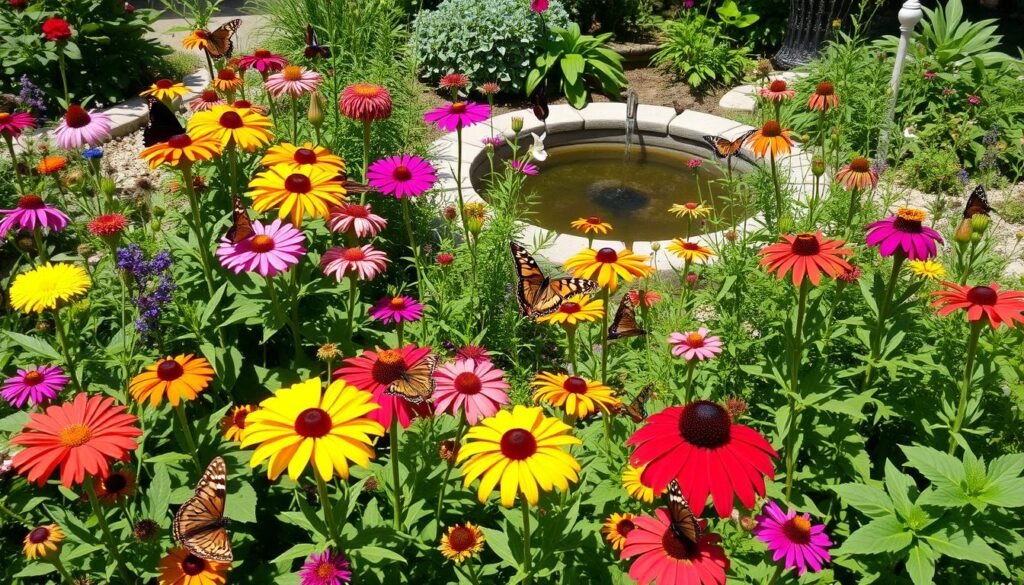
Butterfly Garden Design Tips
To welcome butterflies, design your garden with care. Think about how to make it easy for them to see and move around. Your garden’s layout is key to attracting these pollinators. Choose designs that are not only pretty but also make it easy for butterflies to find food.
Layout Ideas for Pollinator Gardens
When planning your garden, keep these tips in mind:
- Sunlight: Make sure your garden gets 6 to 8 hours of sunlight a day. This is good for both attracting butterflies and keeping plants healthy.
- Accessibility: Make your garden easy for butterflies to move through. Their great eyesight helps them dodge obstacles, so a clear path is best.
- Variety: Mix plants of different shapes, sizes, heights, and colors. A diverse garden will attract more butterfly species.
Planting in Clusters
Planting in clusters is better than having single plants. Grouping plants together can boost pollination. Here are some good cluster ideas:
| Plant Species | Ideal Group Size | Butterfly Species Attracted |
|---|---|---|
| Butterfly Weed | 3-5 plants | Monarchs |
| Purple Coneflowers | 5-7 plants | Various Swallowtails |
| New England Aster | 5-10 plants | Painted Ladies, Common Buckeye |
| Milkweed | 2-4 plants | Monarchs |
| Zinnias | 3-6 plants | Various species, including Monarchs |
By following these design tips, your garden will become a lively home for butterflies and other pollinators.
Timing Your Planting for Maximum Impact
Creating a successful butterfly garden starts with knowing when to plant. Picking the right times ensures a steady food supply for butterflies all year. By planning your planting, you can keep your garden full of nectar for butterflies.
Understanding Blooming Seasons
Each plant blooms at a specific time, which is key for attracting butterflies. For instance, Asclepias (Butterfly Weed) blooms from early summer to fall. It’s vital for monarch butterflies, as they only lay eggs on these plants.
Planting starter plants in spring or fall helps them bloom well. This way, your garden will have a variety of flowers all year.
Planning for Year-Round Interest
To keep your butterfly garden lively all year, plan carefully. Mix native and perennial plants that bloom at different times. This ensures butterflies have food all year.
Choose plants that like the right sunlight and soil. Well-drained soil and full sun are best. Adding host plants for different butterflies and nectar plants for all seasons is key.

| Plant Type | Blooming Season | Best Planting Time |
|---|---|---|
| Asclepias (Butterfly Weed) | Early Summer to Early Fall | Spring or Fall |
| Asters | Late Summer to Fall | Spring |
| Coneflowers | Summer | Spring or Fall |
| Zinnias (Annual) | Summer to Fall | After Frost |
By following these tips, you can create a butterfly garden that blooms all year. This will attract these beautiful pollinators to your garden. For more tips on creating a butterfly-friendly garden, check out this resource.
Butterfly-Friendly Flowers to Include
To make a vibrant butterfly garden, pick the right butterfly-friendly flowers. Mix perennials and annuals for a garden that looks great and welcomes butterflies all season.
Top Perennials for Long-Lasting Blooms
Choose perennials with long-lasting blooms and lots of nectar. Here are some great options:
- Coneflower (Echinacea): Its bright pinkish-purple flowers attract butterflies and feed birds in winter.
- Aster: This North American plant has nectar-rich flowers from August to October, perfect for butterflies.
- Salvia: With its vibrant blooms in summer and fall, Salvia attracts butterflies and hummingbirds.
- Mountain Mint: It draws pollinators in mid-summer, making it a must-have from Zones 5 to 8.
- Joe Pye Weed: Its clusters of pinkish-lavender flowers in late summer are a nectar source for many butterflies.
Annuals That Attract Pollinators
Annuals also add color and nectar for butterflies. Here are some top picks:
- Marigold: Its bright colors are a hit with the Marigold Butterfly.
- Sunflowers: Blooming mid to late summer, sunflowers attract many butterfly species.
- Lantana: It thrives in full sun and attracts butterflies, adding color to your garden.
- Blazing Star: Blooming from July to September, it’s a key nectar source for butterflies.
By choosing the right mix of perennials and annuals, you can create a beautiful butterfly garden. It will support your local ecosystem and look stunning. Learn more about making a beautiful butterfly garden with guides like butterfly garden guides.
Combining Butterfly Plants with Other Pollinators
Creating a vibrant garden is more than just planting butterfly plants. By mixing plants that attract different pollinators, you create a lively ecosystem. This not only attracts butterflies but also bees and hummingbirds, making your garden more exciting.
Bees and Their Favorite Flowers
Some flowers are a hit with bees. For example, pairing butterfly bush with coneflower makes a sunny spot. This mix offers lots of nectar and pollen, attracting honey bees and birds. Adding calamint to your garden helps support a wide range of bees all season long.
Hummingbird Plants That Complement
Hummingbirds prefer tall, tubular flowers. Mountain mint and butterfly bush offer rich nectar, attracting hummers in summer and winter. Adding plants like Dwarf Snow White Hollyhock, which grows 16-24 inches, draws in these pollinators while matching your butterfly plants.
Understanding what different pollinators need and mixing plants wisely turns your garden into a lively haven. Aim for a mix of shapes, colors, and bloom times. This way, your garden stays buzzing with life all year round.
Maintenance Tips for Your Butterfly Garden
To keep a butterfly garden thriving, focus on watering, fertilizing, and managing pests. Using organic methods helps create a safe space for butterflies and other wildlife.
Watering and Fertilizing Your Plants
Watering plants deeply but less often is key. This helps roots grow strong. For fertilizing, choose organic compost or slow-release fertilizers. Plants like Lantana ‘New Gold’ and Gaillardia pulchella do well with these.
Keep an eye on your plants, as they need more water in summer.
Weed and Pest Management Without Chemicals
Dealing with weeds and pests without chemicals is vital. For small gardens, pulling weeds works well. Mulching helps in bigger areas.
Use natural methods to control pests, like introducing ladybugs to fight aphids. Avoid insecticides, as they harm butterflies, mainly when they’re caterpillars.
Try using insect netting or bird habitats to manage pests naturally. Learn more about these methods in the maintenance tips for a butterfly-friendly garden.
Combining annuals and perennials keeps your garden colorful all season. Choose plants like milkweed and parsley for their nectar and as food for caterpillars. With proper care, your garden will attract Monarchs, Swallowtails, and more, creating a lively ecosystem.
Common Mistakes to Avoid When Planting Butterfly Plants
Creating a thriving butterfly garden requires careful planning. Many gardeners unknowingly make mistakes that harm their gardens. These errors can reduce butterfly attraction and plant health.
Overusing Chemical Treatments
Using too many chemical treatments is a big mistake. You might think you’re protecting your plants, but these chemicals harm butterflies and other pollinators. They disrupt the natural balance, causing butterfly numbers to drop.
Instead, choose organic methods or use minimal intervention. This keeps your garden healthy for both plants and butterflies.
Neglecting Plant Variety
Not having a variety of plants is another error. Using only a few types limits the pollinators your garden can attract. Different butterflies need different plants at different times.
For example, milkweed is essential for monarch butterflies. It’s where they lay their eggs. A diverse garden looks better and attracts more butterflies and pollinators.
If you want to improve your garden, learn about native species and planting strategies. Understanding each plant’s needs will make gardening more rewarding. It also helps local butterfly populations.
For more tips, check out this useful resource.
Conclusion
In summary, butterfly plants are key to a healthy garden that draws in pollinators. By picking native plants like black-eyed susan and autumn sage, you help not just butterflies but also bees and hummingbirds. It’s also important to include milkweed, as monarchs are facing a big decline.
When starting a butterfly garden, think about your plants’ needs. Choose ones that fit your local climate, like in North Texas. Make sure your plants get full sun and have good drainage, like milkweed. Also, selecting the right butterfly bushes can help bees during their busy season.
By following these tips, you’ll make your garden more beautiful and help protect important species. Every small step helps a lot. So, start your butterfly garden today and watch it come alive, supporting local pollinators.

